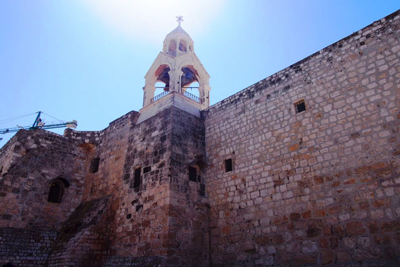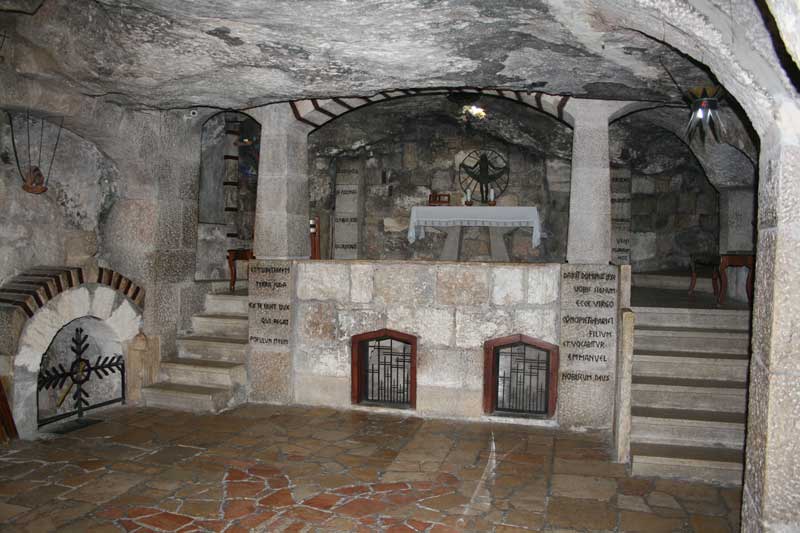
Located 10 km south of the city of Jerusalem, Bethlehem is the place where since at least the 2nd century AD people have believed to be the place where Jesus Christ was born. It is also believed that the site, where the Church of the Nativity now stands is the spot, where Mother Mary gave birth to Jesus. One particular cave, over which the first Church was built, is traditionally believed to be the Birthplace, which marks the beginnings of Christianity and regarded as one of the holiest spots in Christendom. The Nativity Star that can be seen in a limestone grotto beneath the Church, believed to mark the very spot where Mary gave birth to Jesus. The 14 rays of the star represents the 14 generations from Abraham to David, the 14 generations from David to the exile of Babylon and the 14 generations from the exile of Babylon to Jesus' birth.

The basilica that looks like a Bastille is one of the oldest and continuously operating churches in the world that survived various invasions and the change of regimes, numerous catastrophes like, fires and earthquakes. Originally, the church was built by the first Christian Roman Emperor Constantine between 330 and 333 AD and was dedicated on 31 May 339.Unfortunately, the majestic church adorned with beautiful marble and mosaics, was mostly destroyed by fire during the Samaritan revolts against the Byzantine Empire, probably in 529 AD. Subsequently, the Byzantine Emperor Justinian rebuilt the church, who largely preserved the original character of the building, but added a narthex or a porch and replaced the octagonal sanctuary with a traditional cruciform transept, along with three apses. The original basilica church, built by Constantine, parts of which still survives today below the ground, was arranged so that its octagonal eastern end is surrounded and provided a view of the cave, where Jesus was supposed to born. In order to protect it from invaders, the main entrance to the Church was gradually made lower and narrower and two sets of stairs lead down to the Grotto of the Nativity, where the exact spot of Jesus’ birth is marked with a fourteen point Silver Star.

Apart from subsequent additions, especially from the Crusader period, such as two bell towers, which were later lost and partially preserved wall mosaics and paintings, the Church of the Nativity remained basically unchanged since the Justinian reconstruction. However, over the centuries, the surrounding compound has been expanded, increasingly incorporated into a complex of other ecclesiastical buildings, mainly monastic and today it covers approximately 12,000 square meters, comprising three different monasteries, which include the Greek Orthodox, Armenian Apostolic and Roman Catholic, of which the first two contain bell towers built during the modern era.

Over the centuries, Bethlehem and the Church of the Nativity are regarded as a holy pilgrim destination. From Jerusalem to the Church, the eastern end of the traditional route, known as the Pilgrimage route, marks the road that connects the traditional entrance of Bethlehem, near King David’s Wells with the Church of the Nativity. It is extended along the Star Street through the Damascus Gate, also known as Qos Al-Zarara, the historical gate of the town, towards the Manger Square. As it is believed that Joseph and Mary followed the route, it is ceremonially followed by the Patriarchs of the three churches at their several Christmases and during their official visits to Bethlehem.

Unfortunately, as the three custodians of the church, the Greek Orthodox Church, the Armenian Orthodox Church and the Franciscan order were fighting against each other and were unable to agree on a plan of action, the structure remained unattended for a prolonged period. The result ultimately became threatening to the structural integrity of the building. The roof was rotting and parts of the wooden truss structure date to the 15th century and holes in the timbers allow dirty water to drip upon the precious paintings and mosaics below. Although overwhelmingly Muslim, Palestinians consider the church a national treasure and in 2010, the Palestinian Authority announced a multimillion-dollar restoration programme. The initial phase of the restoration work was completed in early 2016, when the structural repairs on the roof were completed, new windows were installed and art works and mosaics have been cleaned and restored. Finally, in 2012, the complex of the Church of Nativity in Bethlehem became the first Palestinian site to be listed as a World Heritage Site.